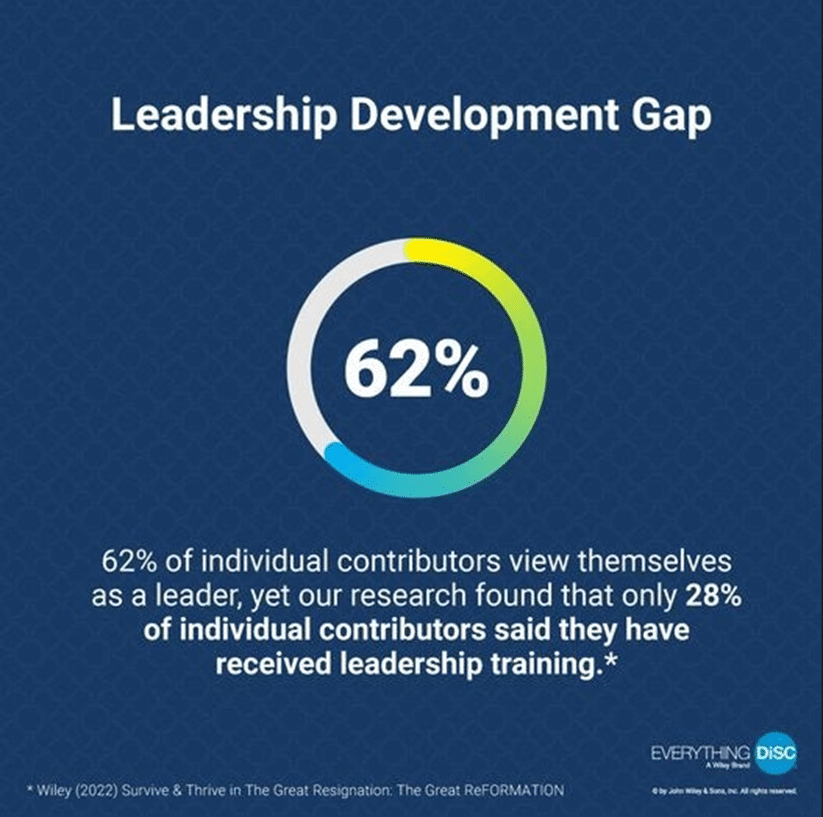Identifying Leadership Potential

Leadership potential isn’t only found in team members who take charge. Leaders might demonstrate other key qualities, like communication skills, the ability to motivate others, and foresight. Your organization is full of leadership potential. Discover how to identify it and develop leadership skills across your organization.
Key Takeaways
- Identify potential leaders by observing their actions and behaviors, not just their titles or vocal presence. Recognize and reward leadership activities to encourage positive change.
- True leaders communicate well, inspire trust, and actively listen. These skills are essential for engaging and motivating others.
- Leaders might be forward-looking, continuously seeking new knowledge, and/or creating a clear vision for the future.
- An ongoing leadership training program prepares helps at various levels to grow.
How to identify leadership potential
We often look for leadership by focusing on charisma and confidence combined with a stellar résumé or academic credentials. These aren’t actually the best way of identifying true leaders.
There are several ways an organization can go about discovering its current and potential leaders. It’s not by looking at the org chart or who speaks up most in meetings, but rather by observing, testing, and asking. Who do people seek out when there’s a big change? How has someone performed when given stretch assignments? Who is quietly lifting up and supporting their colleagues? Who is encouraging positive change in your organization?
Each person may exhibit leadership potential differently. Instead of looking at numbers of direct reports or level of authority, we recommend direct observation when evaluating leadership. Does the person have the skills we’ve listed below? Have they had the chance to show or practice each skill?
Leaders are trustworthy and have integrity
No one will truly listen to or follow someone they can’t trust or respect. Leaders trust and inspire trust.
“Earn trust, earn trust, earn trust. Then you can worry about the rest.”
— Seth Godin, author
“The ability to establish, grow, extend, and restore trust is the key professional and personal competency of our time.”
— Stephen Covey, author
“Leaders have to be flexible with style but firm on character.”
— Lolly Daskal, executive coach
They communicate well
Leaders need to be able to engage, convince, and inspire others. They do this in public and group settings, as well as in private. They encourage growth for the organization and for the people around them.
“You can have brilliant ideas, but if you can’t get them across, your ideas won’t get you anywhere.”
— Lee Iacocca, automobile executive
“Developing excellent communication skills is absolutely essential to effective leadership. The leader must be able to share knowledge and ideas to transmit a sense of urgency and enthusiasm to others. If a leader can’t get a message across clearly and motivate others to act on it, then having a message doesn’t even matter.”
— Gilbert Amelio, president and CEO of National Semiconductor Corporation
“Questions and silence are often more powerful than impressive speeches. When you allow people to fill the space, they usually will. That space is the place where leaders are born.”
— Peter Fuda, researcher and consultant
They listen well
Being an active listener is sometimes a forgotten part of great communication. Leaders need to actively engage in conversation with and gain input from others to completely understand situations and make better decisions. People who feel listened to by their leaders are more likely to speak up and share their ideas and perspectives. Focused and active listeners are better at building trust with their colleagues and subordinates.
“Good leadership requires you to surround yourself with people of diverse perspectives who can disagree with you without fear of retaliation.”
— Doris Kearns Goodwin, author and historian
“When I close my laptop and it’s just me and the person across the table, there’s a connection. There’s energy. There’s the reminder of what’s possible if we focus on what the other person has to say. I’m reminded of why what we’re building together matters.”
— Melissa Daimler, organizational culture and learning advisor
“It’s okay to admit what you don’t know. It’s okay to ask for help. And it’s more than okay to listen to the people you lead—in fact, it’s essential.”
— Mary Barra, former CEO of General Motors
Leaders are forward-looking
Leaders create their vision with others, by listening to others and appreciating their hopes, and by attending to their needs.
“Constituents want visions of the future that reflect their own aspirations. They want to hear how their dreams will come true and their hopes will be fulfilled.”
— James Kouzes and Barry Posner, authors of The Leadership Challenge
“After all, the goal is not just to get people to buy that they need what you have, but to believe what you believe. The goal is not just to hire people who need a job, but who believe what you believe.” — Simon Sinek, author
“If one is lucky, a solitary fantasy can totally transform one million realities.”
— Maya Angelou, civil rights activist and poet
They look for opportunities to learn
In a world where change is constant, leaders need to always be learning. They do this through listening and seeking out new knowledge. They don’t rely on yesterday’s answers to today’s questions.
“Continuous learning leads to continuous improvement. Commit yourself to advancing your knowledge, skills, and expertise. The business environment is quickly changing, and your understanding of the leading practices, thinking, and emerging tools will help you manage for better results. Be a lifelong student.”
— Pamela Gill Alabaster, chief marketing and communications officer, Centric Brands
“Leaders must get comfortable with living in a state of continually becoming, a perpetual beta mode. Leaders that stay on top of society’s changes do so by being receptive and able to learn. In a time where the half-life of any skill is about five years, leaders bear a responsibility to renew their perspective in order to secure the relevance of their organizations.”
— Kenneth Mikkelsen and Harold Jarche, leadership consultants and speakers
They see failure as an opportunity
Leaders are pioneers who seek new opportunities to innovate, grow, and improve.
“Without being willing to fail and continually get back up again, I would never have been able to find the right market and establish my product within it.”
— Kelly Manthey, group chief executive of Kin+Carta
“We need to accept that we don’t always make the right decisions, that we’ll screw up royally sometimes. Understand that failure is not the opposite of success, it’s part of success.”
— Arianna Huffington, founder and CEO of Thrive Global
“Scholars who have studied the development of leaders have situated resilience, the ability to sustain ambition in the face of frustration, at the heart of potential leadership growth. More important than what happened to them was how they responded to these reversals, how they managed in various ways to put themselves back together, how these watershed experiences at first impeded, then deepened, and finally and decisively molded their leadership.”
— Doris Kearns Goodwin
“Lincoln revealed early on a quality that would characterize his leadership for the rest of his life—a willingness to acknowledge errors and learn from his mistakes.”
— Doris Kearns Goodwin
They take action
Leaders make next steps clear. They remove roadblocks. They get people moving and motivated.
“Do not be afraid to make decisions. Do not be afraid to make mistakes.”
— Carly Fiorina, former CEO of Hewlett-Packard
“When people see and feel that they’re moving things forward, it inspires additional effort, engagement, and momentum. But, even when progress is being made, given the daily grind, employees may not see it. So, point it out. Celebrate it. Recognize it. Encourage it. Progress not only feeds momentum; it is momentum.”
— Julie Winkle Giulioni, author and speaker
“But those chosen as remote leaders were doers, who tended towards planning, connecting teammates with help and resources, keeping an eye on upcoming tasks and, most importantly, getting things done. These leaders were goal-focused, productive, dependable and helpful.”
— Arianne Cohen reporting on a 2020 study by Radostina K. Purvanova, et. al.
They’re ambitious and set high expectations, but aren’t impossible to please
“Regardless of your leadership style, it’s important to raise the bar and help your team rise to meet it.”
— Richard Koch, author, and former management consultant
“Resolute leaders stick to their core values. When your values are clear to you and to everyone else in your organization then it simplifies the decision making process.”
— Doug Dickerson, author
“Leadership is not about ‘Follow me because I am great,’ but rather ‘Come with me and help meet the challenges of the day.’”
— Deborah Ancona, professor of leadership at MIT Sloan
They motivate others to achieve success and they prioritize the success of the organization or mission over themselves
Leaders help their organizations, divisions, or teams move more smoothly and quickly toward their vision. They have a vision and core values that drive them and that they share and celebrate with others.
“Great leaders prepare their businesses to spring into action when opportunity presents itself. They do this by fully understanding the context in which they operate, and caring deeply about building and maintaining a healthy working environment.”
— Chris Dalton, associate professor at Henley Business School
“A good leader is able to paint a picture of a vision for the future and then enlist others to go on the journey with her. A truly conscious leader recognizes that it is not about her, but that the team is looking to her for inspiration and direction. Keeping her ego in check is essential.”
— Tamra Ryan, CEO of Women’s Bean Project
“Establish a clear purpose; challenge the team to work out details; traverse conventional departmental boundaries; set large short-term and long-term targets; create tangible success to generate accelerated growth and momentum.”
— Doris Kearns Goodwin
Whenever leadership skills are observed, they need to be rewarded. How are you monitoring leadership activities? How are you recognizing both individuals and teams that display leadership?
Recognizing and rewarding leadership behaviors is essential for reinforcing a culture of continuous development. Calling out examples of great leadership not only empowers individuals but also drives broader organizational benefits, such as improved relationships and increased performance across teams.
Benefits of internal leadership development
A recent Wiley Workplace Research survey found that 20 percent of respondents felt the biggest benefit from leadership training was employee empowerment. Nearly one-third said leadership training improved relationships and engagement. It’s not just for moving an employee into the C-suite. It's for harnessing the leadership potential present in your organization to build a more engaged workplace!
Increased employee performance
Inspired employees are better motivated and better performers. A leadership program like Everything DiSC Work of Leaders® provides a structure and supports feedback to enable better performance. As you teach people how to be better managers and coaches and you see leadership as a one-to-many rather than a one-to-one relationship, you’re teaching people how to motivate those around them. You’re supporting an alignment of purpose. You’ve made it easier for management to set priorities.
Quicker response to crisis
With an ongoing leadership program in place, your top leadership can tap an entire pool of leaders at various levels of your organization when there’s a need to quickly rechannel energies into a new market or initiative or to respond to a crisis. Your leaders-in-training will have practiced giving their staff the answer to “why” as well as “who, what, and when.” Employees will have seen their leaders act in accordance with clearly defined goals in the past and will more likely trust in their ability to act together in a time of crisis.
A good leadership program will include the concept and consequences of risk. People will be counseled to stretch or restrain their natural tendency for risk. People will have learned how to lead from their strengths and develop the areas in which they are weak. Therefore, your leadership at all levels will have a wealth of options on how to respond quickly. They won’t necessarily just go to the behaviors and tactics that feel comfortable for them.
Improved retention rates
Engaged employees are less likely to leave for greener pastures. They see the pastures greening around them. Hopefully, they see their own contributions to keeping the pasture green.
Your observations about the people you send through a leadership program will also give you more information about those you want to retain and those for whom additional training might never pay off. If you’re making your values and the company’s values explicit, those who do not align with those values will become apparent.
Developing leaders
Recent Wiley research shows that 62 percent of individual contributors view themselves as a leader, but only 28 percent of individual contributors have received leadership training.

Organizations can support the development of leadership, not just individual leaders. We recommend using products like Everything DiSC Work of Leaders® and The Leadership Challenge to be at least part of any leadership training program. They will contribute to developing the softer skills required by today’s leaders.
Mentoring can be helpful if good matches are made, and both the mentor and mentee receive training on how to manage their mentoring relationship. Mentoring doesn’t always come naturally and not everyone expects the same thing from the relationship.
Of course, the best teacher is experience. Setting stretch goals, offering feedback, providing opportunities for self-reflection, hiring a coach, and other actions can also generate powerful learning experiences.
— John P. Kotter, author, professor, and business entrepreneur
The success of any ongoing leadership program is achieved through communication and transparency.
- Everyone should understand how potential leaders are chosen for the program.
- Everyone going through your program should come out with a common vocabulary, a common story, a way of communicating with each other and with their staff.
- Everyone should be able to give informed feedback to others: from testing assumptions to initiating action to offering feedback and praise.
It doesn’t end with those being trained, however. The entire organization needs to see and understand how the leadership program works, how they can get involved, and how it pays off for the individuals involved and for the entire organization.
Posted 12/07/2022







